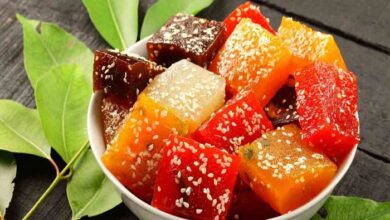Tasty Black: A Culinary Exploration of the Dark Side of Food

The color black often evokes negative connotations, associated with darkness, evil, and death. However, in the culinary world, black represents a spectrum of tantalizing flavors and aromas that challenge our perceptions and push the boundaries of taste. From bold and earthy to delicate and sweet, black ingredients offer a unique and captivating dimension to our culinary experiences.
Unveiling the Dark Side of Flavor
The color black in food is often associated with strong, intense flavors. Black garlic, for instance, undergoes a slow and complex fermentation process that transforms its sharp, pungent taste into a mellow, umami-rich depth. Similarly, black cardamom, with its smoky, resinous aroma, adds a touch of intrigue to savory dishes and sweet confections alike.
Exploring the World of Black Ingredients
Black ingredients span a diverse range of cuisines and cultures, each contributing its own distinctive flavor profile. Black truffles, the epitome of culinary luxury, are prized for their earthy, musky aroma and intense umami taste. Black sesame seeds, a staple in Asian cooking, impart a nutty, slightly sweet flavor to dishes, while black rice, with its chewy texture and subtle sweetness, provides a nutritious and versatile alternative to white rice.
Embracing the Darkness in Sweet Delights
Even in the realm of sweet treats, black ingredients find their place. Licorice, with its polarizing flavor profile, offers a unique blend of sweetness, bitterness, and aniseed notes. Dark chocolate, with its rich, intense cocoa flavor, evokes a sense of sophisticated indulgence. And black cherries, with their tart, juicy sweetness, add a burst of flavor to pies, jams, and desserts.
The Visual Appeal of Black Cuisine
Beyond their captivating flavors, black ingredients also bring visual drama to our plates. Black sesame seeds, scattered atop a bowl of noodles, add a touch of elegance. Black squid ink, swirled into risotto or pasta, creates a striking contrast of colors. And black lava cakes, oozing with molten chocolate, offer a visually stunning and decadent dessert experience.
Pairing Black Ingredients for Culinary Harmony
The key to unlocking the full potential of black ingredients lies in understanding their unique flavor profiles and pairing them with complementary elements. Black garlic, for instance, pairs beautifully with rich meats, earthy vegetables, and creamy sauces. Black sesame seeds enhance the flavors of stir-fries, salads, and baked goods. And dark chocolate harmonizes with bold cheeses, tart fruits, and spicy accents.
Embracing the Culinary Dark Side
By venturing into the world of black ingredients, we embark on a culinary adventure, exploring the depths of flavor and challenging our preconceptions about taste. Black cuisine is not about darkness or negativity; it is about embracing the unexpected, celebrating the bold, and discovering the hidden gems that lie beneath the surface.
Conclusion
The color black in food represents a culinary paradox, a symbol of both mystery and intrigue. It is a color that challenges our perceptions, pushing us to explore the boundaries of taste and discover the unexpected. Black ingredients, with their rich and complex flavors, offer a unique and captivating dimension to our culinary experiences. They invite us to embrace the dark side of food, not with fear or trepidation, but with curiosity and excitement, for it is within the depths of darkness that we often find the most profound and transformative flavors.
FAQ
- What are some of the most common black ingredients used in cooking?
Black garlic, black cardamom, black sesame seeds, black truffles, black rice, black squid ink, licorice, dark chocolate, black cherries.
- How can I incorporate black ingredients into my cooking?
Black garlic can be used as a flavor enhancer in sauces, dressings, and marinades. Black cardamom can be added to savory dishes, sweet confections, and beverages. Black sesame seeds can be used as a garnish, topping, or ingredient in breads, pastries, and stir-fries. Black truffles can be shaved over pasta, risotto, or eggs. Black rice can be used as a side dish, grain bowl base, or ingredient in salads and soups. Black squid ink can be used to color pasta, risotto, or sauces. Licorice can be used to flavor candy, beverages, and desserts. Dark chocolate can be enjoyed on its own, used in baking, or paired with fruits, cheeses, and spices. Black cherries can be eaten fresh, cooked into pies and jams, or used in desserts and sauces.




